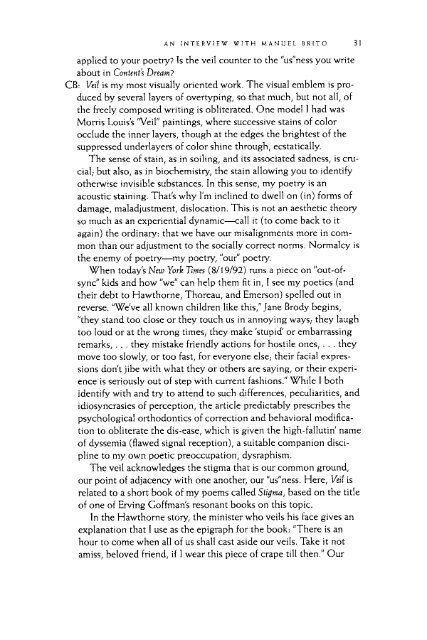My Way_ Speeches and Poems - Charles Bernstein
My Way_ Speeches and Poems - Charles Bernstein
My Way_ Speeches and Poems - Charles Bernstein
Create successful ePaper yourself
Turn your PDF publications into a flip-book with our unique Google optimized e-Paper software.
AN INTERVIEW WITH MANUEL BRITO 31<br />
applied to your poetry? Is the veil counter to the "us"ness you write<br />
about in Content's Dream?<br />
CB: Veil is my most visually oriented work. The visual emblem is produced<br />
by several layers of overtyping, so that much, but not all, of<br />
the freely composed writing is obliterated. One model I had was<br />
Morris Louis's "Veil" paintings, where successive stains of color<br />
occlude the inner layers, though at the edges the brightest of the<br />
suppressed underlayers of color shine through, ecstatically.<br />
The sense of stain, as in soiling, <strong>and</strong> its associated sadness, is crucial;<br />
but also, as in biochemistry, the stain allOWing you to identify<br />
otherwise invisible substances. In this sense, my poetry is an<br />
acoustic staining. That's why I'm inclined to dwell on (in) forms of<br />
damage, maladjustment, dislocation. This is not an aesthetic theory<br />
so much as an experiential dynamic-call it (to come back to it<br />
again) the ordinary: that we have our misalignments more in common<br />
than our adjustment to the socially correct norms. Normalcy is<br />
the enemy of poetry-my poetry, "our" poetry.<br />
When today's New York Times (8/19/92) runs a piece on "out-ofsync"<br />
kids <strong>and</strong> how "we" can help them fit in, I see my poetics (<strong>and</strong><br />
their debt to Hawthorne, Thoreau, <strong>and</strong> Emerson) spelled out in<br />
reverse. "We've all known children like this," Jane Brody begins,<br />
"they st<strong>and</strong> too close or they touch us in annoying ways; they laugh<br />
too loud or at the wrong times; they make 'stupid' or embarrassing<br />
remarks, ... they mistake friendly actions for hostile ones, ... they<br />
move too slowly, or too fast, for everyone else; their facial expressions<br />
don't jibe with what they or others are saying, or their experience<br />
is seriously out of step with current fashions." While I both<br />
identify with <strong>and</strong> try to attend to such differences, peculiarities, <strong>and</strong><br />
idiosyncrasies of perception, the article predictably prescribes the<br />
psychological orthodontics of correction <strong>and</strong> behavioral modification<br />
to obliterate the dis-ease, which is given the high-fallutin' name<br />
of dyssemia (flawed signal reception), a suitable companion discipline<br />
to my own poetic preoccupation, dysraphism.<br />
The veil acknowledges the stigma that is our common ground,<br />
our point of adjacency with one another, our "us"ness. Here, Veil is<br />
related to a short book of my poems called Stigma, based on the title<br />
of one of Erving Goffman's resonant books on this topic.<br />
In the Hawthorne story, the minister who veils his face gives an<br />
explanation that I use as the epigraph for the book: "There is an<br />
hour to come when all of us shall cast aside our veils. Take it not<br />
amiss, beloved friend, if I wear this piece of crape till then./I Our


